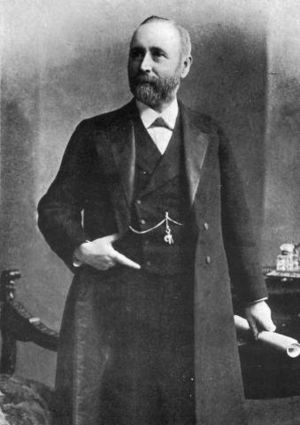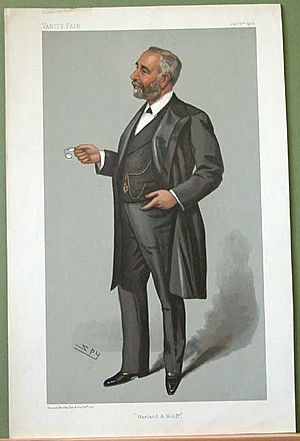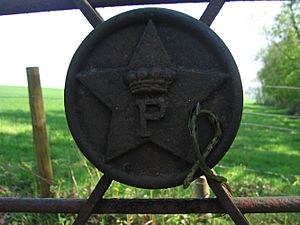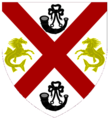William Pirrie, 1st Viscount Pirrie facts for kids
William James Pirrie, 1st Viscount Pirrie (born May 31, 1847 – died June 7, 1924) was a very important British shipbuilder and businessman. He was the chairman of Harland and Wolff, a famous shipbuilding company, from 1895 to 1924. He also served as the Lord Mayor of Belfast from 1896 to 1898.
Pirrie was given special titles during his life. He became a Baron in 1906 and a Viscount in 1921. Before the RMS Titanic disaster in 1912, Lord Pirrie was asked about the number of lifeboats on the Olympic-class ships. He famously said that these huge ships were unsinkable. This statement would stay with him forever. In Belfast, he was also a well-known figure because he was a Protestant employer who supported Home Rule for Ireland. This was a big political issue at the time.
Quick facts for kids
William Pirrie, 1st Viscount Pirrie
|
|
|---|---|
 |
|
| Born | May 31, 1847 Quebec City, Canada East
|
| Died | June 7, 1924 (aged 77) At sea off Cuba
|
| Burial place | Belfast City Cemetery |
| Nationality | British |
| Occupation | Shipbuilder, businessman |
| Spouse(s) | Margaret Montgomery Pirrie (m. 1879-1924) |
| Family |
|

Contents
Early Life and Family Connections
Pirrie was born in Quebec City, Canada East, in 1847. His parents, James Alexander Pirrie and Eliza Swan Pirrie, were both from Ireland. When he was two years old, his family moved back to Ireland. He grew up in Conlig, County Down.
William Pirrie came from an important family. His nephews included some very notable people. J. M. Andrews later became the Prime Minister of Northern Ireland. Thomas Andrews was the chief designer of the famous RMS Titanic. Another nephew, Sir James Andrews, 1st Baronet, became a top judge in Northern Ireland.
A Career in Shipbuilding and Public Service
Pirrie went to school at the Royal Belfast Academical Institution. In 1862, he started working as an apprentice at the Harland and Wolff shipyard. An apprentice learns a trade by working with experienced people. Twelve years later, in 1874, he became a partner in the company.
When Sir Edward Harland died in 1895, Pirrie became the chairman of Harland and Wolff. He held this important position until he died. Under his leadership, Harland and Wolff became the largest shipyard in the world.
Serving the City of Belfast
Besides his work in shipbuilding, Pirrie also served the city of Belfast. He was elected Lord Mayor of Belfast in 1896. He was re-elected the next year. In 1898, he became Belfast's first honorary freeman. This is a special title given to people who have done a lot for their city. He also held important roles as High Sheriff of Antrim and High Sheriff of County Down.
In 1900, he became the President of the UK Chamber of Shipping. This organization represents shipping companies in the United Kingdom. He had been the vice-president the year before.
Political Involvement and Honors
Pirrie supported the Liberal Party in Ulster. He helped them financially in the 1906 general election. In the same year, because of Harland and Wolff's great success, he was given the title of Baron Pirrie.
In 1907, Pirrie was appointed to a role in the household of the Lord-Lieutenant of Ireland. In 1908, he received another high honor, becoming a Knight of St Patrick. He was also a leader at The Queen's University of Belfast from 1908 to 1914. Before the First World War, he was involved in committees about Irish finance. He also served as Lieutenant for the City of Belfast in 1911.
Political Challenges and the Titanic
In February 1912, Pirrie chaired a meeting where Winston Churchill spoke about Home Rule for Ireland. This was a very controversial topic. After the meeting, Pirrie was booed and even attacked in Larne. People threw rotten eggs, fish, and bags of flour at him. This shows how strong feelings were about Home Rule at the time.
Just two months later, in April 1912, Pirrie was supposed to travel on the RMS Titanic. However, he became ill and could not make the journey. This illness saved his life, as the ship sank on its first trip. His nephew, Thomas Andrews, who designed the Titanic, sadly died on board.
War Work and Later Life
During the First World War, Pirrie was part of the War Office Supply Board. In 1918, he became the Comptroller-General of Merchant Shipbuilding. In this role, he organized the building of merchant ships for Britain during the war. These ships were vital for carrying supplies.
In 1921, Pirrie was elected to the Senate of Northern Ireland. In the same year, he was given the higher title of Viscount Pirrie. This was in recognition of his important work during the war and his charity efforts.
Personal Life and Legacy
Lord Pirrie married Margaret Montgomery Carlisle on April 17, 1879. In 1909, Lord Pirrie bought Witley Park, a large estate. The letter "P" with a crown above it, which was Pirrie's family emblem, can still be seen on gates and fences there.
Pirrie also built a structure called the Temple of the Four Winds near the Devil's Punchbowl in Hindhead. Only the base of this building remains today.
William Pirrie died on June 7, 1924, at the age of 77. He passed away from a lung illness while on a business trip off the coast of Cuba. His body was brought back to New York on the RMS Olympic, a sister ship to the Titanic. He was buried in Belfast City Cemetery. Since he had no children, his titles of Baron and Viscount ended with him. Lady Pirrie, his wife, died in 1935. A special memorial to Lord Pirrie was placed in the grounds of Belfast City Hall in 2006.
Images for kids





